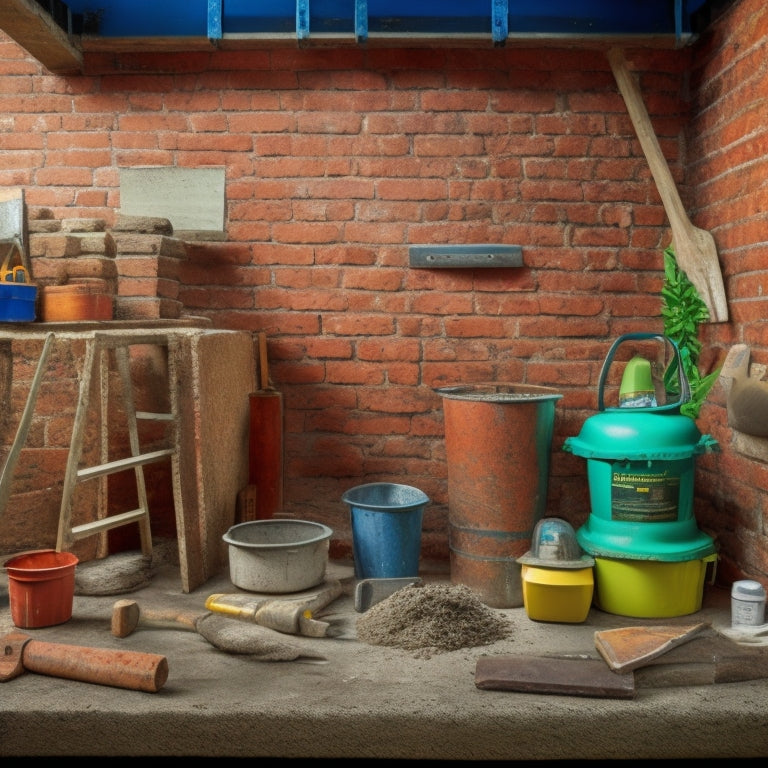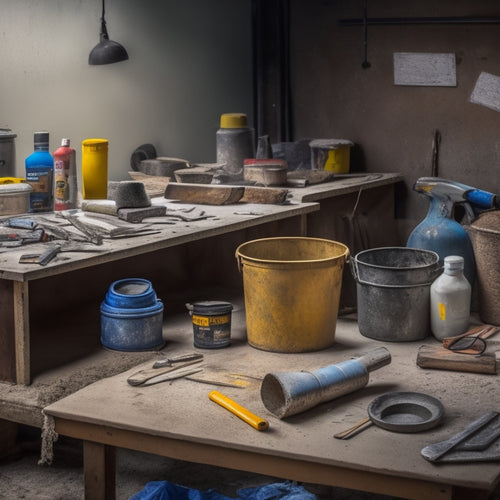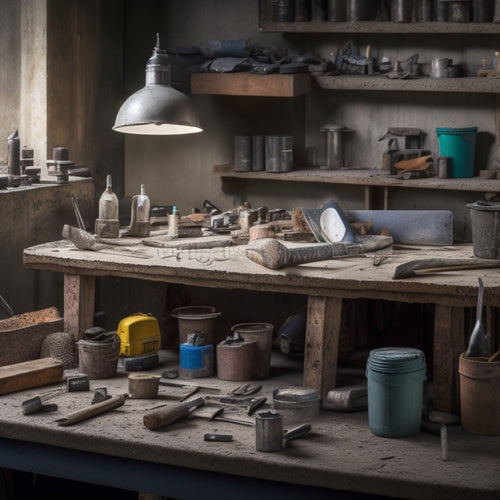
7 Best Tools for Laying Concrete Masonry Walls
Share
When laying concrete masonry walls, you'll need a range of specialized tools to guarantee a structurally sound and visually appealing outcome. Essential tools include tamping tools like handheld tampers and plate compactors, leveling and aligning equipment like laser levels and alignment sticks, and mix and pour bucket necessities like reliable buckets and mixing sticks. You'll also require block cutting and shaping tools, mortar mixing and laying gear, pointing and finishing tools, and safety and protective equipment. With the right tools, you'll be well on your way to constructing a high-quality concrete masonry wall - and there's more to explore on how to use them effectively.
Key Takeaways
- A handheld tamper and plate compactor are essential for compacting and consolidating concrete in masonry walls.
- Laser levels and alignment sticks ensure accurate leveling and alignment of walls to prevent structural issues and aesthetic flaws.
- A reliable bucket, mixing stick, and trowel are necessary for mixing and pouring concrete to achieve a smooth, even finish.
- Block saws, block chisels, and pointing trowels are crucial for precise cutting and shaping of concrete blocks and mortar joints.
- Personal protective equipment, such as hard hats and safety glasses, is vital for job site safety when laying concrete masonry walls.
Tamping Tool Essentials
Every concrete masonry wall project requires a few essential tamping tools to secure a strong, durable, and visually appealing structure.
You'll need a handheld tamper, a plate compactor, and a bull float to guarantee proper consolidation and finishing of the concrete. When selecting tamping tools, consider the size and scope of your project, as well as the type of concrete you're working with.
Mastering tamping techniques is fundamental to achieving a smooth, even finish.
You'll need to develop a consistent rhythm when tamping to avoid over- or under-compacting the concrete. Regular tamping maintenance is also important to extend the lifespan of your tools.
Clean and lubricate your tamping tools regularly to prevent rust and corrosion. Additionally, perform routine inspections to identify any worn or damaged parts that need replacement.
Leveling and Aligning Equipment
You'll need to verify your concrete masonry walls are perfectly level and aligned to achieve a professional-looking finish. Even the slightest deviation can lead to structural issues, compromised integrity, and an unsightly appearance. To confirm accuracy, you'll require specialized equipment.
Laser levels are an essential component in your arsenal, providing a precise reference point for your walls. These devices project a level line or dot, enabling you to check your work in real-time. Opt for a self-leveling laser, which automatically adjusts to the surrounding environment, saving you time and effort.
In conjunction with laser levels, alignment sticks will help you maintain a consistent layout. These rods, typically made of fiberglass or aluminum, are marked with precise measurements, allowing you to transfer layout lines from one course to the next.
Mix and Pour Bucket Needs
Several critical components come into play when mixing and pouring concrete for your masonry walls. You'll need a reliable bucket that can handle the demands of mixing and pouring concrete. Look for a bucket that's sturdy, has a non-slip handle, and is made of durable materials that can withstand the rigors of heavy use.
When it comes to mixing techniques, you'll want to make sure you're using the right tools for the job. A mixing stick or trowel is essential for achieving the perfect mix. You'll also need to take into account the mixing ratio, as this will affect the strength and consistency of your concrete.
Practice different mixing techniques to find what works best for you and your project.
In terms of pouring methods, you'll need to decide on the best approach for your specific wall layout. Will you be pouring into a form, or directly onto the wall? Do you need to use a pump or conveyor belt to reach higher areas?
Having the right pouring method in place will make certain a smooth, even finish and reduce the risk of errors.
Block Cutting and Shaping Tools
As you prepare the concrete mix and pour it into place, the next step is to shape and cut the masonry blocks to fit the wall's design. This requires precision and the right tools to guarantee accurate cuts and shapes.
You'll need a block saw, a powerful tool that can cut through concrete blocks with ease. There are different types of block saws available, including electric, gas-powered, and manual options. Choose one that suits your needs and the size of your project.
In addition to a block saw, you'll need shaping tools to refine the edges and surfaces of the blocks. A block chisel is essential for removing excess concrete and creating a clean finish. A pointing trowel is another must-have for shaping and smoothing out the mortar joints.
You may also need a hammer, tape measure, and square to guarantee accurate measurements and precise cuts. With these block cutting and shaping tools, you'll be able to create a professional-looking masonry wall that meets your design specifications.
Mortar Mixing and Laying Gear
Mortar, the bonding agent that holds your masonry wall together, requires precise mixing and laying to guarantee a strong, durable structure. You need to select the right mortar type for your project, considering factors like compressive strength, workability, and color. There are several mortar types to choose from, including Type S, Type N, and Type M, each with its own unique characteristics.
When it comes to mixing, you'll need a reliable mixer, such as a paddle mixer or a drum mixer, to guarantee consistent results. Mix your mortar according to the manufacturer's instructions, using the correct ratio of cement to sand to water. You'll also need a mixing tub or bucket to hold your mortar, as well as a shovel or trowel for scooping and applying it.
Proper mixing techniques are essential for achieving the right consistency and preventing defects. You'll want to mix your mortar in a circular motion, scraping the sides and bottom of the tub to guarantee all ingredients are well incorporated.
Pointing and Finishing Tools
About three-quarters of the way through your masonry project, you'll shift your focus from laying courses to pointing and finishing the joints. This critical phase requires specialized tools to attain professional-looking results.
You'll need a pointing trowel, which has a flat, broad blade and a comfortable grip, to fill and smooth the joints. A finishing trowel with a curved blade is used to create a concave joint profile, allowing for better water runoff.
For more precise control, use a jointer or a finishing tool to remove excess mortar and create a clean, defined joint. You can choose from various pointing techniques, such as bucket handling, pointing with a pointing trowel, or using a jointer.
Finishing methods include tooling, brushing, or using a sponge to achieve the desired texture and appearance.
When selecting pointing and finishing tools, consider factors like handle material, blade shape, and size to guarantee they suit your specific needs and preferences.
With the right tools and techniques, you'll be able to achieve well-crafted joints that enhance the overall appearance of your masonry wall.
Safety and Protective Equipment
You've invested time and effort into laying courses and pointing and finishing the joints, but now it's time to focus on the often-overlooked aspect of masonry work: safety and protective equipment.
Don't underestimate the importance of safeguarding yourself and your team from potential hazards on the job site. Personal protective equipment (PPE) is essential to prevent injuries from falling objects, flying debris, and exposure to hazardous materials.
Wear hard hats, safety glasses, and dust masks to protect your head, eyes, and respiratory system. Steel-toed boots and gloves will shield your feet and hands from heavy objects and sharp edges.
Guarantee your site safety by setting up warning signs, barricades, and netting to prevent accidents. Implement a fall protection plan, especially when working at heights. Regularly inspect your equipment and tools to prevent malfunctions.
Frequently Asked Questions
How Do I Achieve Uniform Joint Spacing in My Concrete Masonry Wall?
To achieve uniform joint spacing, you'll need to master joint alignment techniques. Start by using spacing measurement tools, such as a story pole or a joint spacer, to guarantee accurate spacing and avoid costly rework.
Can I Use a Laser Level for Indoor Masonry Projects?
Like a conductor leading an orchestra, you direct your masonry project's harmony with precision. Yes, you can use a laser level for indoor masonry projects, leveraging its benefits, such as increased accuracy and efficiency, to perfect your indoor masonry techniques.
What Is the Ideal Temperature for Laying Concrete Masonry Walls?
When laying concrete masonry walls, you'll want to guarantee the ideal temperature, as it notably impacts concrete hydration. Aim for temperatures between 50°F and 70°F (10°C and 21°C) to optimize hydration, minimizing temperature effects that can compromise structural integrity.
How Often Should I Clean My Concrete Masonry Tools?
Imagine a painter's brush clogged with dried paint - that's what happens to your concrete masonry tools without regular cleaning. You should clean them daily, or after every 500-700 units, to maintain tool performance and prevent damage, ensuring ideal results.
Are There Any Specific Regulations for Concrete Masonry Wall Construction?
You'll need to familiarize yourself with local masonry codes and national safety standards, such as OSHA and ASTM guidelines, to guarantee your concrete masonry wall construction meets regulatory requirements and minimizes risk.
Conclusion
You've made it to the end of the concrete jungle, armed with the best tools for laying concrete masonry walls. It's ironic that the most essential part of the process is often overlooked - the person behind the tools. Remember, a skilled craftsman with subpar tools can still produce exceptional work, but the reverse is rarely true. So, don't just invest in the tools, invest in yourself.
Related Posts
-

3 Best Tools to Buy for Concrete Repair Online
When buying tools for concrete repair online, you'll want to research multiple retailer options to find the best prod...
-

Top Tools for Concrete Repair Success
When it comes to concrete repair success, you'll need a well-stocked toolkit with essential hand tools like trowels, ...
-

10 Best Tools for Sealed Concrete Finishing Success
When it comes to sealed concrete finishing success, you need a robust arsenal of specialized tools. Start with essent...


